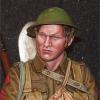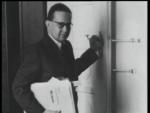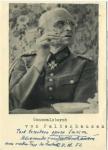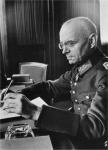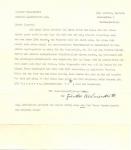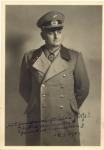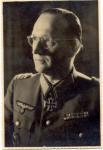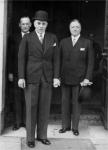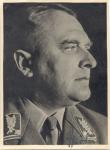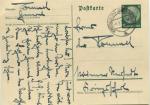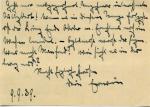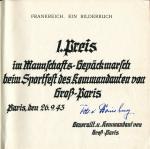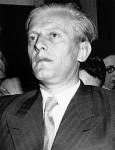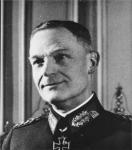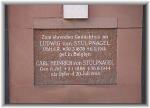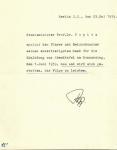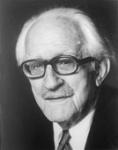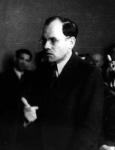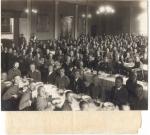-
Posts
701 -
Joined
-
Last visited
-
Days Won
1
Content Type
Profiles
Forums
Blogs
Gallery
Events
Store
Everything posted by ColinRF
-
Here is the text of Napoleon's decree sent with this letter: 20/06/1805 D?cret sur l'organisation de la Garde royale TITRE I : Dispositions g?n?rales Article I : la Garde royale sera compos?e de : 1 corps de Gardes d'Honneur 1 corps de V?lites 1 corps de Garde de ligne. TITRE II : Des Gardes d'Honneurs Article 2 : il sera form? dans notre Royaume d'Italie, 4 compagnies de Gardes d'Honneur qui porteront les noms suivants : - 1?re Cie de Milan - 2?me Cie de Bologne - 3?mc Cie de Brescia - 4?me Cie de la Romagne Article 3 : chaque compagnie sera compos?e de 100 hom?es dont 60 ? cheval et 40 ? pied. Article 4 : ces compagnies seront form?es des fr?res,fils, pefit-fils, neveux et petit-neveux et cousins des membres des trois coll?ges et des jeunes gens de la conscription,fils ou neveux des plus impos?s des d?partements. Article 5 : La compagnie de Milan sera compos?e des jeunes gens des d?partements de l'OLONA,de l'AGOGNA,du LARIO et de l'ADDA. La compagnie de Bologne sera compos?e des jeunes gens des d?partements du RENO, du CROSTOLO, du PANARO et du MINCIO. La compagnie de Brescia sera farm?e des jeunes gens des d?partements du SERIO, de l'ALTO PO, de la MELLA et de l'ADIGE. La conpagnie de la Romagne des jeunes gens des d?partements du RUBICONE et du BASSO PO. Article 6 : Jusqu'? ce ces compagnies soient au complet,aucun fr?re,fils, petit-fils,neveu, petit-neveu ou cousin des membres des trois coll?ges ou fils ou neveu des plus impos?s des d?partements qui les uns ou les autres se trouveraient de la conscription ne seront admis ? se faire remplacer. Article 7 : Ces compagnies feront le service aupr?s de la personne du Roi. Article 8 : Deux ans de service dans ces compagnies donneront le grade de sous-lieutenant. Article 9 : Tous ceux qui y seront admis devront avoir un revenu de 1200 livres de Milan ou de leurs biens propres ou en une pension assur?e par leurs parents, tous les trimestres ? la caisse de la compagnie et seront sold?s aux gardes tous les mois ? raison de 100 livres par mois. Article 10 : Il sera fourni aux gardes ? cheval, un cheval harnach? et des rations pour la nourriture du cheval. Les hommes tant ? pied qu'? cheval recevront pour la nourriture et les v?tements un pr?t de 30 livres par mois. L'armement et les casernements seront fournis par les magasins royaux. TITRE III : Des V?lites Royaux Article 11 : Il sera form? 12 compagnies de Gardes V?lites composant 3 bataillons de 4 compagnies. Article 12 : Les bataillons de V?lites royaux feront le service aupr?s de la personne du Roi; pendant la paix ils seront employ?s ? la garde des palais et pendant la guerre ? la d?fense de sa personne. Article 13 : Chaque d?partement fournira une compagnie ? l'exception du CROSTOLO qui sera ? cet effet r?uni au PANARO et de l'ADDA qui sera reuni au LARIO. Article 14 : Les compagnies de l'OLONA, de l'AGOGNA, du LARIO et de l'ALTO PO formeront le Premier Bataillon,les conpagnies du PANARO, du BASSO PO, du RENO et du RUBICONE le Deuxi?me Bataillon; les compagnies du SERIO, de la MELLA, de l'ADIGE et du MINCIO le Troisi?me Bataillon. Article 15 : Chaque compgnie sera compos?e de 100 hommes dont 3 officiers, 4 sergents et 8 caporaux. Article 16 : Les masses de boulangerie, d'habillemcnt, de chauffage et autres seront les m?mes que celles de la Garde royale de ligne ? pied. La solde sera de 10 sols de Milan par jour. Article 17 : Les parents de chaque V?lite leur assureront annuellement une somme de 200 livres de Milan qui sera vers?e dans les caisse du corp. Cette somme sera distribu?e aux v?lites par portions de 5 jours en 5 jours en forme de suppl?ment de pr?t. Article 18 : Le remplacement pour la conscription ne sera permis dnas les d?partements que lorsque les compagnies de V?lites de ces d?partements seront compl?tes. Article 19 : Apr?s deux ans de service les V?lites royaux auront le rang de sergent, ils en porteront la distinction et pourront entrer dans ce grade dans les troupes de la ligne. TITRE VI : Des Gardes de la Ligne Article 20 : Les Gardes de la Ligne seront compos?es de : - un escadron de 4 compagnies de dragons. Chaque compagnie sera de 100 hommes dont 60 ? cheval et 40 ? pied. Le corps sera command? par un colonel. - un r?giment d'infanterie de 2 bataillons, le premier de 5 compagnies de grenadiers et le deuxi?me de 5 compagnies de chasseurs. Chaque compagnie sera de 100 hommes. - une compagnie d'artillerie l?g?re. Cette compagnie sera de 64 hommes. Les Gardes de la ligne n'auront qu'un seul Conseil d'administration. Article 21 : Tous les individus existants dans la Garde royale actuelle y conserveront leur grade et leur droit. Article 22 : Le corps de la Garde de la ligne sera d?sormais recrut? parmi les hommes des corps de la Ligne qui auront 5 ans de service et qui se seront distingu?s par leur tenue, leur conduite et leur bravoure Article 23 : Exc?cution... 29/06/1805 D?cret sur les uniformes de la Garde Royale d'Italie Art 1 : Gardes d'honneur - Milan : habit ? la fran?aise rouge ? revers, col, parements et retroussis gros bleu. Boutonni?res en argent. Aiguilettes et tr?fles en argent. Culotte et veste blanches. Sabre de dragon et bottes ? la cavali?re. Chapeau bord? en argent. Mousqueton et giberne ? fourniment en galon argent. Selle de veau laqu? blanc, housse et chaperons gros bleu ? galon argent. - Brescia : bleu ? distinctive cramoisie. Housse et chaperons cramoisis et galon argent. - Bologne : blanc ? distinctive gros bleu. Housse et chaperons gros bleu ? galon argent. - Romagnes : vert ? distinctive ?carlate. Housse et chaperons ?carlates ? galon argent. Art 2 : V?lites royaux Habit blanc avec col et revers verts. Epaulettes rouges. Bonnet de grenadiers. Fourniment complet. Culotte et veste blanches. Gu?tres noires.
-
Erich Kordt, like his brother Theo, was a foreign service officer in the German government. Like his compatriot Adam von Trott zu Solz, he spoke fluent English and was educated partially at Oxford, the recipient of a Rhodes Scholarship. Kordt joined the Foreign Office in 1928 and was initially posted to Switzerland. He then served as Legationsrat or counsellor in the London Embassy under Ambassador von Ribbentrop, for he had personal and professional contempt. He joined the Nazi Party in 1937 as this was de rigeur for any foreign service officer hoping to keep his job. In February 1938, once Ribbentrop became Foreign Minister, Kordt was appointed head of the Foreign Office's "Ministerial Bureau". Both Kordt brothers were heavily involved in the so-called Oster conspiracy in 1938. This was the first and probably the most likely to succeed coup pan developed by the resisters. Kordt was involved in two ways ? firstly he volunteered to assassinate Hitler with a bomb as he had personal access to the Chancellery. However, at this pre-war stage, explosives and silent fuses were not easily procured, even by senior officers in the Abwehr, and Kordt's offer could not be acted upon. Instead, Oster organised a planned arrest of Hitler should he trigger a war with Czechoslovakia and Britain/France of the Sudetenland. As Beck said at the time, "Bring me certain proof that England will fight if Czechoslovakia is attacked, and I will put an end to this regime." All they needed was a firm stand by the British government, as occurred in 1939 over Poland. The plan was for Erich Kordt to open the doors to the Chancellery to a commando team located in apartments across the road. This team was commanded by Werner Schrader's friend, Friedrich Wilhelm Heinz, later a commander of a Brandenburger battalion. Oster and Heinz developed a secret plan within the overall plan to shoot Hitler during his arrest, as they were the only ones who realised that Hitler's death was a necessary pre-condition to a successful putsch. Kordt visited the Chancellery often over several days at all hours to ensure that the guards were used to his presence and to put them at ease. Unfortunately the whole plan came to naught when Chamberlain flew to Munich to appease Hitler. Theodor Kordt, who acted as Charge d'Affaires at the London embassy, was considered a vital contact with the British on whom the success of the plot depended. The conspirators needed strong British opposition to Hitler's seizure of the Sudetenland. Erich used his brother as an envoy to urge the British government to stand up to Hitler over the crisis, in the hope that Army officers would stage a coup against Hitler. In June 1939, Kordt went to London to warn Robert Vansittart, the diplomatic advisor to the British government, of the secret negotiations between Germany and the USSR which were to lead to the Nazi-Soviet non-aggression pact. He was dismayed that all approaches made by the German resistance movement within the German Foreign Office were ignored by the British, a pattern that was repeated throughout the pre-war and following periods. In April 1941, Kordt was posted to Tokyo as German embassy First Secretary and later to Nanking as German Consul, where he worked as an agent for the Soviet spy Richard Sorge until 1944. He narrowly avoided being killed by a Japanese assassin when Japanese Intelligence discovered that his espionage activities. In June 1948, at the Nuremburg war crimes trials, Kordt testified on behalf of Ernst von Weizsaecker, who was being tried for his and the Foreign Office's role in facilitating Hitler's aggressive foreign policy. Despite clear evidence of Weizsaecker's key role in trying to depose Hitler and stop the war before it started, he was convicted. No British foeign service officer would confirm his testimony for fear of embarrassing the British government by making it clear that the war could have been avoided. Partly as a result of his testimony in support of Weizsaecker, Kordt aroused the hostility of Federal Chancellor Adenauer, who blocked Kordt's return to a career at the Foreign Office. From 1951, Kordt was a professor of international law at the University of Cologne. The page below is a signed book dedication by Erich Kordt.
-
Cat salute? BDOS? I hope those are good things. Alexander Ernst Alfred Hermann Freiherr von Falkenhausen was the German general who served as Governor of Belgium and Northern France during the occupation by German troops. Coincidentally, he was related Ludwig von Falkenhausen, who served as Governor General of occupied Belgium in 1917-18. Falkenhausen was commissioned as a second lieutenant in the German Army in 1897 and served as a military attache in Japan prior to the First World War. He was awarded the Pour le Merite or "Blue Max" during the war while serving on secondment with the Turks in the Middle East. After the war he stayed in service and later headed the Dresden Infantry School in 1927. In 1930 he retired from service and went to China to serve as Chiang Kai-Shek's military advisor. When Japan joined the Axis in 1937, Falkenhausen was recalled to Germany as it was no longer politically expedient to have him advising an enemy of his own country. Chiang declined to grant permission for von Falkenhausen's exit as he was custodian of the complete suite of China's strategic secrets. When informed of this, Foreign Minister von Ribbentrop threatened to have von Falkenhausen's family incarcerated in a concentration camp. When informed of this, Chiang gallantly gave von Falkenhausen permission to leave, asking only for his word of honour that no secret information would be disclosed. Upon his return, von Falkenhausen just as gallantly refused to provide any information to his own government or military, despite being strongly pressed to do so. Von Falkenhausen was recalled to active duty in 1938. He served as an infantry general on the Western Front until his appointment as military governor for Belgium in May 1940. While serving as military governor his administration published 17 decrees against the Jewish population of Belgium as preparatory measures leading in June 1942 to the Final Solution and the deportation of 28,900 Jews. His deputy for economic affairs, Eggert Reeder was responsible for the destruction of "Jewish influence" in the Belgian economy, leading to mass unemployment of Jewish workers, especially in the diamond business. Some 2,250 of these unemployed were thus sent to forced labour camps in Northern France in order to build the Atlantic Wall for the Todt Organisation. Some 43,000 non-Jewish Belgians were also deported to German camps of which 13,000 died. In addition, hundreds of resistance fighters were shot by the German army during the occupation. He was a close friend of anti-Hitler conspirators Carl Goerdeler and Erwin von Witzleben and like them he came to loathe the Hitler administration. He offered support to von Witzleben for a planned coup d'etat in 1938 and 1939. Early in the war, he tried to lure Hitler into visiting his headquarters where he had the intent of arresting him. Hitler was wise enough to decline all such invitations. After the failure of the July plot, von Falkenhausen was arrested and he spent the rest of the war transferred from one concentration camp to another. His name was found amongst the files in the Dohnanyi archive discovered in Zossen following Oberstleutnant Schrader's suicide. He probably would have been executed except for the late April 1945 date of discovery and the extent of disorganisation in the Reich at that date. Von Falkenhausen was part of a column of 140 high value prisoners including the families of many of the executed resisters and others such as Generaloberst Halder, Leutnant Fabian von Schlabrendorff, and arrested British agents Stephens and Best of Venlo fame. Scheduled for immediate execution by their SS guard if liberation looked likely, the hostages were liberated by Wehrmacht soldiers and turned over to American forces. Von Falkenhausen was instrumental in making contact with the commander of the German troops. After his liberation, von Falkenhausen was sent to Belgium for trial in 1948, and in March 1951 he was sentenced to 12 years hard labour for deporting 25,000 Jews and executing Belgian hostages. However, he was acquitted and released three weeks into his sentence after overwhelming evidence proved that he had tried to save as many Jews and Belgians as possible from deportation and execution.
-
Guenther Blumentritt was a Bavarian, born in Munich in 1897. He joined the German Army and during the First World War he served on the Eastern Front. Blumentritt was a close friend of Erich von Manstein. He served as a staff officer in the invasions of Poland in 1939 and France in 1940. In 1941, he served in the Russian Campaign before returning to Germany to serve as Chief of Operations. He strenuously opposed the invasion of Russia, noting unavoidable parallels between the German plan and that of Napoleon in 1812. He tended to concur with Hitler's blindly applied no retreat policy, again citing the fate of Napoleon's army during its collapse in 1812. There is controversy surrounding the extent of Blumentritt's involvement in the July plot. David Irving, whose interpretations are now discredited, but who was no slouch at uncovering rare documents, heavily implied that Blumentritt was in the know prior to the bomb attack on Hitler. At the time of the Stauffenberg bomb attack, Blumentritt was Chief of Staff for von Rundstedt in his capacity as Commander in Chief West. In his post-war "other side of the hill" interviews with Basil Liddell-Hart, Blumentritt admitted that Hans Speidel had drawn him aside in March 1944 and, speaking for Rommel said: "The time has come when we must tell the Fuehrer that we cannot continue the war." With the agreement of von Rundstedt, a telegram was sent to Hitler to this effect - no reply was received. Subsequently, Speidel informed Blumentritt that there were men in Germany who were preparing to depose Hitler. He specifically identified von Witzleben, Hoepner, Goerdeler and Beck. Blumentritt later asserted that Speidel did not raise the spectre of assassination although this must be considered disingenuous as a man as smart as Blumentritt must have known that there was no prospect of a successful coup while Hitler lived. The famous telegram sent by von Rundstedt, followed by his "make peace you fools" phone call with Keitel, provided the impetus for Rundstedt's removal and replacement by Guenther Hans von Kluge. Blumentritt remained in his role as von Kluge?s Chief of Staff. On July 20, Blumentritt was front and centre as von Kluge initially welcomed news of Hitler's assassination and prepared to halt V-1 attacks on England and open negotiations with the Allies. Later, as mixed news emerged, he advised von Kluge to call Wolfschanze where no one could be found to confirm or deny Hitler;s death. In the end, it was Blumentritt who correctly interpreted the circumstantial evidence to mean that there had been an unsuccessful attempt on the Fuehrer. After von Kluge made his decision to detach himself from the plotters, Blumentritt advised him to send Hitler a message of congratulations on his survival. He also was instrumental in concert with Ambassador Abetz, in brokering the mutually agreed fiction adhered to by Heer and SS officer alike that the arrests on July 20 had been an exercise. This had the effect of limiting the Gestapo's victims in Paris to less than a dozen officers. Blumentritt was called to attend on Hitler and he fully expected to be arrested and perhaps executed given the fates that had befallen other senior commanders in France. Instead, Hitler conferred the Knight's Cross on him and ironically put him in command of an SS Corps. Blumentritt survived the war with his military and personal reputation largely intact. The letter below is the transmittal cover for the signed picture. The group shot includes (from the left) Blumentritt, Speidel, Rommel and von Rundstedt at the latter's HQ Roche Guyon Paris.
-
Generalleutnant Hans Speidel was, like Rommel and Stauffenberg, a Swabian from the Wurtemburg area. He represented one of the younger and more energetic members of the resistance. He is sometimes presented as having come to the side of the conspirators only after experiencing two years of brutal and total war on the eastern front but it should be remembered that Speidel served as an aid to Beck for diplomatic assignments in the pre-war period and he was almost certainly influenced by him. Speidel served in the First World War and he stayed with the Reichswehr in the inter-war period becoming a General Staff officer and reaching the rank of Lieutenant-Colonel by 1939. He served in the French campaign as Chief of Staff to the military commander in France and in 1942 he was transferred East, becoming Chief of Staff to V Corps. By 1943, he was Chief of Staff to Army Group South and a Generalmajor. In 1943, Speidel was Chief of Staff to General Hubert Lanz. In this role, he conspired with Lanz and one of his Corps commanders, Hyazinth von Strachwitz, to kidnap and, if necessary, kill Hitler during an expected front visit at Poltava on February 17. The plan failed when Lanz retreated in violation of "stand fast" orders and was relieved. In April 1944, Rommel asked for him and Speidel was transferred west to become Chief of Staff to Army Group B, the primary defensive force for the coming Normandy invasion. In this position, Speidel did much to influence Rommel to join, or least not impeded the conspirators in their efforts to unseat Hitler. There is talk, mostly based on sloppy history by David Irving, that Speidel deliberately sabotaged German operational efforts to respond to the Normandy invasion by withholding panzer reserves that could have been committed. However, this has been discounted by Rommel's naval aid von Ruge: "There does not exist any proof, and betrayal certainly was not in Speidel's nature." After Rommel's wounding in a strafing attack on July 17, 1944, Speidel continued in his role as Chief of Staff to Army Group B, now serving Generalfeldmarschall Hans von Kluge who was performing the dual roles of Commander of Army Group B and Command in Chief West. He was unaware of the pending July 20 attack even though he was engaged as a full member of the conspiracy. Given that just two full days had passed between von Kluge's assumption of command and the bomb attack on Hitler, Speidel had no opportunity to brief von Kluge on the conspirators? plans, despite the fact that he was known to be generally supportive of removing Hitler. During July 20 in Paris, Speidel had little opportunity to influence events as they played out very quickly between late afternoon when orders were given by von Stuelpnagel to arrest all SS and Gestapo personnel. Later in the evening, it became apparent that Hitler had survived and was still in control. After the collapse in Paris, very few officers were arrested compared to Berlin. Despite clear evidence of a pervasive resistance effort. This could have been due to a reluctance to disrupt the command structure on a critical front but was more likely due to a sham cover story agreed to between the army and SS to explain the reasons for the arrests. Speidel was not spared however. He was arrested by the Gestapo and interrogated. David Irving says that he implicated Rommel under torture but Speidel's close post-war friendship with the Rommel family belies this accusation. It is clear that Hitler believed Speidel guilty. However, he was one of the few, if not the only one, who was considered for expulsion from the Wehrmacht by the army court of honour chaired by von Rundstedt and who was not expelled. It is thought that Speidel's close contacts with senior officers like Guderian protected him. Expulsion from the Wehrmacht was a necessary pre-condition for trial before the Peoples' Court so Speidel was effectively protected from both the security service and Hitler's judiciary. Nevertheless Speidel was jailed by the Gestapo. At the end of the war he escaped and was saved by French troops. After the war, Speidel was involved in the creation of the Bundeswehr, rising to full general and Commander in Chief of all Nato ground forces in Europe. The signed (on rear) portrait photo below is a rarely seen one of Speidel in his Heer uniform. The other photo is a pre-war shot of Speidel (left) with Beck on a diplomatic assignment.
-
Karl Stroelin was Lord Mayor of the Swabian city of Stuttgart. Like Carl Goerdeler, he was a conservative politician who was an initial admirer of the demonstrated strength and national priorities of the Nazis. Only when Nazi crimes became apparent did he begin to lose faith in Hitler and move into the opposition camp. He was the son of a career officer and he fought in the First World War. He left the army as a direct result of the downsizing that resulted form the Versailles Treaty. He earned a doctorate with a thesis on the situation of the workers and middle class after the war. He was drawn into the sphere of the Nazi party in the 1920's and joined it in 1931. In 1931, Stroelin ran for election as Lord Mayor of Stuttgart as the Nazi candidate, he was decisively defeated. Instead, he ran for and succeeded in winning a position on the city council. After the rise of Hitler in 1933, Stroelin became Lord Mayor. His main administrative duties as Mayor focused on urban planning and housing matters. Stroelin was also the chairman of the German Foreign Institute, effectively mayor of the notional administrative city that incorporated all overseas Germans. He was chosen for this role as a result of the fact that many emigrants form Germany were Swabians. After the war, he was accused of encouraging and administering German international intelligence and fifth column activities. It was established at Nuremburg that he intervened with Nazi authorities, including Freisler, to save several people from death sentences. Stroelin was a close friend of Rommel. In the film "The Desert Fox," he was portrayed by Cedric Hardwick who quite accurately applies influence on the Swabian Field Marshal to revolt against Hitler. It is thought that Stroelin's influence was key in getting Rommel to turn against Hitler, even in the limited way he did so. After the July 20 bomb attack, Stroelin's house was searched by the Gestapo but nothing incriminating against him was found. Nevertheless, he was still suspected given his contacts with Goerdeler and Rommel and he lost his party rank. As French and American troops advanced on Stuttgart in April 1945, the Nazis declared the city to be a fortress and called for its defenders to fight to the last. As a former officer Stroelin knew that the city could not be defended. The city had already been significantly damaged by air attack and a ground assault could only lead to the loss of remaining buildings and inhabitants. Stroelin risked his life and reputation and made the bold move to secretly contact the French army and he offered the peaceful surrender of his city. The Gestapo learned of his contact with the Allies and obtained an arrest warrant against him. However, transmission of the arrest order was sabotaged and he was not arrested in the waning days of the war. Stroelin as a Lord Mayor of a major German city and senior Nazi leader was initially seen as a major Nazi offender. When the Allies came to understand his involvement with the July plot and resistance, he was released on bail and quickly processed through the denazification courts. He was a witness at the Nuremburg war crimes trials, primarily in support of von Neurath. After the war, Stroelin was shunned by the left and the right given his Nazi past and as a result of his surrender of Stuttgart.
-
I did! And they would be majic to own but I'm not sure of the market value in these tough times. While their provenance would make them a treasure for me, unfortunately the peaks of cash available for collecting do not always coincide with the availability of nice items! Thanks for the heads up! Colin
-
January 4, 1941Dear Hausser! Many thanks for your kind letter dated December 28 and your good wishes for 1941 which I heartily reciprocate. Your son is a strapping mountaineer. I enjoyed your pictures very much. To the sorrow of my family I spent Christmas out here very quietly. Albeit, that cannot be helped. The story about the flares against tanks in the "Ghost Division" is, of course, incorrect. Otherwise the book is well written. With best wishes from our house to your house. Yours, E. Rommel
-
Rommel, recently promoted Generalmajor, and now Commandant of Hitler's mobile headquarters and commander of the Fuehrer's escort battalion, writes a post card in ink to his wife Lucie in Wiener Neustadt. The card was mailed from Kreuzberg in East Prussia and is dated September 9, 1939, only six days into World War II. Dearest Lu! We are now in the North. In the Northern edition of the Voelkische Beobachter you can see your general next to the Fuehrer at the Vistula River in Graudenz. Things are going amazingly well for me. Almost interesting news. If we manage to maintain this pace, the war will be over in the West by the end of October, in my opinion. It was well managed you will probably say. What is Manfred doing? How do they see things at the Castle? Right hearty greetings, Your Erwin. September 9, 1939
-
Erwin Rommel, Germany's "Desert Fox," is probably the best known of Hitler's commanders. Despite serving a criminal regime, he managed to gain and retain the respect of both his countrymen and his enemies. Rommel is credited with doing his best to fight a chivalrous war, even under "total war" conditions. For example, he was one of the few commanders who refused to implement Hitler's infamous "Commando Order" that required the execution of all captured commandos and saboteurs, whether taken in uniform or not. A professional soldier, Rommel served in the elite Alpine Corps during the Great War. He was wounded three times, earned the Iron Cross (first and second class) and was awarded Prussia's highest decoration for valour, the Pour Le Merite or "Blue Max." Between the wars, he was an instructor at the Dresden Infantry School from 1929 to 1933 and at the Potsdam War Academy from 1935 to 1938. In 1937, he published his lecture notes, base don his war diaries, as a much-read manual entitled "Infanterie Greift An" (Infantry Attacks). In 1938, Rommel, now an Oberst, was appointed to command Hitler's personal protection battalion, the Fuehrer Begleitbattalion. Promoted to Generalmajor in 1939, he commanded the Fuehrer's mobile headquarters throughout the Polish campaign. In 1940, Rommel was given command of 7. Panzer Division, later nicknamed the Gespenster-Division (Ghost Division). Remarkably, this was Rommel's first command of a panzer unit. As a reward for outstanding performance in France, Rommel was given command of the German mobile troops that were being sent to North Africa to assist the defeated and dispirited Italians. It was in command of this "Deutches Afrika Korps" that Rommel would achieve his greatest notoriety in the fluid battles fought across the North African desert in 1942. He became the darling of the Nazi press and even Churchill saluted his skills in parliament. In 1943, he was invalided home from Africa, before the inevitable surrender of German forces. After his return from Africa, Rommel was unemployed for a period, although he did command the German forces entering Italy after that country's surrender and withdrawal from the Axis. Rommel did his best to shore up the beach defences of the "Atlantic Wall" after being placed in command of Heeresgruppe B and made responsible for defending the French coast against the expected Allied invasion. He sought Hitler's permission for his preferred strategy for deploying Germany's mobile reserves close to the likely invasion beaches. Hitler chose instead to keep his tanks in deep reserve until they could be used en masse after Allied intentions became crystal clear. History shows that Rommel's strategy would have served Germany better. The Allies gained a foothold in Normandy and for that point, Rommel judged that the war in the west was lost. Several members of Rommel's staff were heavily involved in the anti-Hitler conspiracy within the Wehrmacht including his Chief of Staff Hans Speidel, his chief naval aid Friedrich Ruge, and his personal aid Hellmuth Lang. In addition, other high ranking officers serving in the West were involved, particularly General von Stuelpnagel, the Military Governor of occupied France. During Rommel's command in France, several attempts were made to recruit him as an active resister. On several occasions, the conspirators directly approached him. Dr. Karl Stroelin, the Oberbuergermeister of Stuttgart lectured Rommel and appealed to his conscience on multiple occasions. Hans Speidel arranged for Stuelpnagel's adjutant and cousin, Caesar von Hofacker to approach Rommel and seek his approval to assist the plotters by surrendering in the West. On July 11, 1944, Hofacker returned to Berlin to brief Stauffenberg and Goerdeler, thinking Rommel was solidly behind the conspiracy. Lucie Rommel has always maintained that her husband would not have approved of an assassination plot and that he only wanted Hitler deposed, arrested and tried as a criminal. On July 15, 1944, the same day that Stauffenberg made his first abortive attempt to kill Hitler at Wolfschanze, Rommel wrote to Hitler informing him that it was his opinion that the war was lost and imploring him to make peace. The letter was sent in early August by his successor Hans Guenther von Kluge after Rommel was seriously wounded on July 17, 1944 when his staff car was strafed, most likely by an RCAF spitfire flown by Flt Lt. Charlie Fox, DFC. The Generalfeldmarschall was returning from a briefing session with Sepp Dietrich, the commander of the 1. SS Panzer Korps. In August, Rommel was well enough to return home to recuperate. From then on things started to go steadily downhill for him as various bomb plot conspirators were tortured and interrogated by the July 20 Special Commission. In October 1944, Rommel was invited to attend upon Hitler at his headquarters to discuss future employment, but he was not well enough to travel. Instead, Generals Burgdorff and Maisel were dispatched to meet with Rommel at his home. They brought with them the shocking news that Rommel had been implicated in the plot, ostensibly by von Hofacker and Speidel. Inclusion of his name on the conspirators' list of prospective members of a post-coup government did not assist his case. It is also possible that von Stuelpnagel mentioned Rommel's name after his suicide attempt while delirious. Rommel was presented with the choice of honourably killing himself of facing the People's Court under Freisler. He realised that he would never reach Berlin alive if he selected the second option as his name was too important to public opinion to allow it to be publicly listed among the conspirators. He would clearly become the victim of a staged SS accident if he tried to get to Berlin and his family would suffer accordingly. On October 14, 1944, Rommel said goodbye to his family and personal staff and drove off with Burgdorff and Maisel. He took cyanide after the staff car stopped on a country lane not far form his home. He was given a state funeral with full honours and it was not until after the war that the truth of his fate and the nature of his involvement with the Stauffenberg plot became known in Germany and in the West.
-
Very creative presentation. Are you concerned about acid damage? I may have missed it but this doesn't look like acid free paper. My wife's best friend is a papers conservator by profession so I get lectured constantly about not touching my autographs bare handed and making sure they are mounted acid free. Again - great idea. Colin
-
Hans Freiherr von Boineberg-Lengsfeld was born on June 9, 1889, in Eisenach. He served in WWI, and in armoured troops in the early years of WWII when he won a Knight's Cross. He was the Commandant of the Greater Paris area at the time of the July 20 attempt. However, Boineburg-Lengsfeld had stated to Generalfeldmarschall Erwin von Witzleben as early as 1942 that he was ready to take part in a coup, at the time that he was still with 23. Panzer Division. On July 20, his was a key position as he had personal command of Heer troops of the Paris garrison. Boineburg-Lengsfeld was fully briefed on the plans for the coup and was fully in support. He was recruited into the conspiracy against Hitler by General Karl Heinrich von Stuelpnagel, the military governor of France. He helped Stuelpnagel and his aid Colonel Caesar von Hofacker develop an operational plan to seize control of Paris on X-Day (the anticipated date of the coup d'etat). On July 17, he was informed by Stuelpnagel that the assassination would be attempted within a few days and that he was to arrest all of the regime's security personnel in Paris. Boineburg-Lengsfeld then made sure that he had an up to date map showing all relevant locations. On July 20, 1944. Boineberg-Lengsfeld led the 1st Garrison Regiment of 325. Security Division in a lightning strike against all SS, SD and Gestapo bases throughout the Paris metropolitan area. These were simultaneous raids intended to result in the disarming and arrest of all of the regime's security apparatus in Paris, and by extension across France. Within one hour, the entire SS, SD, and Gestapo contingent in Paris was in army custody, including senior SS police commanders Carl Oberg and Helmuth Knochen. Boineburg-Lengsfeld personally supervised the operation. The arrests were carried out flawlessly with absolutely no resistance being shown by the SS, despite the fact that some thought they were being taken prisoner by French resistance personnel disguised in German uniforms. But within hours of Stuelpnagel's brilliant coup, Boineberg-Lengsfeld is compelled to release all SS officials following Hitler's radio broadcast and Kluge's refusal to back Stuelpnagel. Admiral Krancke, in command of about 5,000 marines camped outside Paris also threatened to intervene and with the collapse of Stauffenberg's coup in Berlin, the decision was made that continuing in Paris would risk civil war. Owing to Stuelpnagel and Hofacker's resourceful cover-up of the Paris-based conspiracy, Boineberg-Lengsfeld escaped the Gestapo's suspicion and survived the war. Given his close association with the conspiracy and his hand in the SS arrests, he was removed from his post as Commandant of Paris and succeeded by General Dietrich Von Choltitz of "Is Paris Burning?" fame. He was put in reserve in August 1944 and served as a commander of fortress troops thereafter. He was taken prisoner and was released June 30, 1946. He died November 20, 1980, in Felsberg-Altenburg, Hessen. The signature below is on a book awarded as a prize.
-
Signed photograph of Otto Abetz, German Ambassador to France. An art teacher, Otto Abetz lent his support to the Nazi Party in 1931 and joined the German Foreign Office as a French expert in 1935. He spent a lot of time in France, but was thrown out of the country in 1939 when the French cracked down on a secret fascist association called the Cagoulards. He returned after the German victory in 1940 and in August was named ambassador to the Vichy government. He served in that position for four years (1940 - 1944). His obligations as ambassador included dealing with all political matters in both occupied and unoccupied France and counseling the German military and police administration in Paris, the capital of Nazi occupied France. His main responsibility was to make sure the French collaborated with the Nazis in furthering their anti-Semitic goals. He played a large part in the deportation of both foreign Jewish refugees and French-born Jews, particularly after Germany occupied southern France in the fall of 1942. In Paris in 1937, during a visit to Picasso's studio, Abetz pointed to the painting Guernica and asked Picasso, "Did you do that?" Picasso very appropriately responded: "No. You did." Abetz was not a resister, but he did play a key role in limiting the scope of Hitler's revenge on the officers in Paris who had, after those in Berlin, proceeded the furthest with implementing the Valkyrie orders. When they were made aware of the bomb attack on Hitler, Stuelpnagel and Hofacker moved ahead quickly to arrest of all SS and SD personnel in Paris. Only when the plot was clearly frayed and the navy threatened to intervene did they agree to Generalfeldmarschall von Kluge's order to release the detainees. At this point, Abetz personally intervened to avoid reprisals. He trained all of his diplomatic skills on a furious SS and Police Leader Brigadefuehrer Oberg, arguing that any rift between the army and SS would lead to catastrophe in France. He brokered a truce that led to Oberg and von Stuelpnagel actually shaking hands in the Hotel Raphael. It was agreed that the Valkyrie detentions would be represented as an exercise and that they would all stick to the same cover story. As a result, arrests and executions of conspirators in Paris were relatively limited in scope despite clear evidence of treason. After the war, Abetz was tried for war crimes and sentenced to 20 years hard labor. He served just five. Released in 1954, he and his French wife were burned to death in an automobile "accident" on the Cologne-Ruhr autobahn in 1958 when something went wrong with their car's steering wheel. It is suspected that his death may have been a revenge killing for his role in sending French Jews to the gas chambers.
-
Autograph collector's card signed by Karl-Heinrich v. Stuelpnagel when Quartermaster II of the OKH. As early as 1938, General der Infanterie Karl-Heinrich von Stuelpnagel was heavily involved in conspiring against Hitler's regime in his roll as a subordinate of Ludwig Beck. But his most significant involvement was as Military Governor (France), a post he held from 1942 to July 20, 1944. Stuelpnagel was the most committed resister on the western front and he did his utmost to fill his staff with like-minded officers and to influence others, including Generalfeldmarschall Rommel, that something must be done to unseat the Nazis before it was too late. As his ADC was Stauffenberg's cousin Oberstleutnant Caesar von Hofacker, Stuelpnagel knew of the July 20 attempt in advance. When he observed Generalfeldmarschall von Kluge's hesitation, Stuelpnagel moved quickly to force Kluge's hand by following Generalfeldmarschall von Witzleben's order calling for the immediate arrest of all Gestapo and SD personnel in the local area. The regime's entire security establishment in Paris was uprooted and placed under arrest within in a matter of hours and firing squads were tasked to shoot certain senior functionaries on the morning of the 21. Only when it became widely known that the plot had failed was Stuelpnagel's order rescinded. Kluge was furious that Stuelpnagel had tried to tip him into supporting the conspiracy by using such methods and duly reported his July 20th activities to Berlin in an effort to exonerate himself. But he also encouraged his subordinate to "get into civilian clothes and disappear somewhere," knowing that this was not the way for such a man of honour. On July 21, Stuelpnagel received Keitel's ominous order to report personally to Berlin. Embarking on his last trip by car, he instructed his driver to detour and break the journey on the old Verdun battlefield. Stuelpnagel got out, taking a short walk beside a canal where he had fought in WWI and, when out of sight, shot himself in the head. He fell into the adjoining waterway but was rescued by his staff. His failed suicide attempt destroyed his optic nerves and resulted in blindness in both eyes. Stuelpnagel was nursed back to some degree of health before he was tried in the Volksgerichtshof and sentenced to death by hanging on August 30, 1944.
-
Thanks again for the kind comments. Now, moving on to some signatures and bios related to July 20 in Paris: This bio is a compilation from various internet sources: Generalfeldmarschall Hans Guenther von Kluge holds a key position as one of the few officers who claimed adherence to the conspiracy between 1943 and 1944. Despite the fact that he was privy to the conspirators' detailed plans and agreed form time to time to support them, he could never follow through. He always pulled back before the decisive moment and as a result, he is counted among the conspirators but is generally viewed as the personification of the opportunity lost. In 1943, von Kluge was the commander of Army Group Centre. His chief of operations was Colonel Henning von Tresckow, the prime mover of the 1943 plots and of the rewriting of Operation Valkyrie to suit the plotters' plans. In 1944, von Kluge had switched to be Commander in Chief West, a role that was crucial to the outcome of the July Plot overall. Kluge served on the General Staff from 1910 to 1918. During the inter-war period, he rose quickly through the ranks to colonel in 1930, major-general in 1933 and lieutenant-general the following year. After 1936, Kluge was given command of an army corps. His interest in mobile warfare soon won Hitler?s notice. Kluge was personally repelled by Hitler's Capone-like political style and he was equally disturbed by the way in which the Jewish persecution was carried out, although it is unclear whether this was based on morality or a disagreement on tactics and optics. In the September 1939 campaign against Poland, Kluge proved to be an outstanding military leader. In Poland, von Kluge achieved spectacular successes. He also recoiled in horror at the crimes of the Einsatzgruppen. Consistent with his later moral cowardice, Kluge commented on these crimes but did nothing to impeded them. In early 1939, von Kluge heard the shocking news that Hitler planned to wage war against the West at the earliest opportunity. He pondered whether or not to join the conspirators in their second major coup plan (the first being Oster's plan in 1938 that was scuppered by Chamberlain folding his hand at Munich). He decided to decline given Hitler's immense popularity with the German people and troops. But he did not report the conspirators, consistent with his ideas of honour and with their status as brother officers. The October 1939 coup attempt would be aborted by Army Chief of Staff General Franz Halder based on his belief that Hitler was aware of the conspiracy. This fear emerged from Hitler's vow to "destroy the spirit of Zossen" (the headquarters of the General Staff) as he became frustrated with lukewarm support for his aggressive plans from his generals. In June '41, Hitler awarded Kluge a field marshal's baton and selected him to be a senior general in the invasion of Russia. Kluge served in Army Group Centre and was promoted to its command after Feodor von Bock was stricken with illness. Hitler's generalship and inability to come to terms with even the most requisite of retreats made Kluge come to doubt his fitness for command, possibly even his sanity. Throughout 1943, von Kluge began to establish contact with the resistance, welcoming senior resisters at his headquarters and attending secret meetings in Berlin. The resisters can be forgiven for assuming that von Kluge was on side with their plans. Upon taking over Army Group Centre, von Kluge found his conscience in operations officer, von Bock's nephew General Staff Colonel Henning von Tresckow. Tresckow was the heart and sole of the military resistance, perhaps doing more than any other officer to ensure that Hitler was removed form power. Tresckow immediately sensed an opportunity in von Kluge and he never missed an opportunity to turn von Kluge more toward the conspiracy. He also used von Kluge's general sympathy for the conspiracy as a chance to set up a resistance cell primarily of aristocratic general staff officers in Army Group Centre. Harold Deutsche noted that there are four general phases to the resistance: the first phase in 1938 was centred on the Abwehr; the second phase in 1939 on the Army High Command in Zossen; the third in 1943 was centred on the Tresckow cell in Army Group Centre in Russia and the final phase in 1944 was centred on the reserve army HQ in the Bendlerstrasse. In March 1943, Tresckow succeeded in luring Hitler to visit Army Group Centre HQ near Smolensk. Several assassination attempts were planned and one was initiated (more on these when I get to the Army Group Centre bios). Despite knowledge of the plans, von Kluge did not assist. Rather, he obstructed Tresckow but again did not report any of his detailed knowledge. Von Kluge's tenure as commander of Army Group Centre ended with a serious traffic accident. When ready to report back for duty, von Kluge was assigned to the Western Front. On June 29, 1944 he was appointed Generalfeldmarschall von Rundstedt's replacement as Commander in Chief West following that officer's famous "make peace you fools!" exclamation to Keitel. Kluge was now commander of all the German forces in France and was now in a position to give the conspirators the pivotal support they needed for their coup. Upon taking over the West, von Kluge was of the opinion that Rommel and von Rundstedt were overly pessimistic, until he arrived and observed how bad things truly were. After making a series of visits to the front, von Kluge landed firmly back in the conspirators' camp, particularly after a visit by the conspirators' liaison, Stauffenberg's cousin Colonel Caesar von Hofaecker. On July 16, military governor for Paris and co-conspirator General Karl Heinrich von Stuelpnagel informed Rommel and Kluge here would be a coup attempt very soon. Kluge promised to help only if they succeeded in killing Hitler while Rommel promised to cooperate with fewer provisos. Rommel was seriously wounded by air attack the next day and the absence of his support and decisive leadership is sorely missed 3 days later. On July 20, Stuelpnagel threw his weight decisively behind the coup, issuing orders for the arrest of all SS, SD and Gestapo personnel in Paris without informing von Kluge. Once von Kluge learned of Hitler's survival, it was clear that it was futile to expect any support from this quarter. In fact he is claimed to have stated: "I would have gone along if the swine had been dead!" As soon as von Kluge found out what Stuelpnagel had done, he countermanded that officer's arrest orders and took steps to free the arrested security personnel. He also lost no time in contacting Wolfschanze to express his loyalty and to report Stuelpnagel. Hitler was immediately suspicious about von Kluge but he was key to the defence of this front and could not be replaced. On August 15, 1944, von Kluge decided to pay a front line visit to his troops near the deteriorating Falaise Gap. Caught by over powering allied air power, his command car and radio destroyed by airstrike, von Kluge and his close staff were incommunicado for more than 24 hours. That was too much for Hitler who immediately assumed that von Kluge was making contact with the Americans and readying the front for a unilateral surrender. He may have been right. Dr. Udo Esche, Kluge's son-in-law (who provided the cyanide capsule with which the field marshal later commited suicide) told Allied interrogators that Kluge had contemplated surrender and "went to the front line but was unable to get in touch with the Allied commanders." Hitler removed him before he could regain contact and replaced him with Generalfeldmarschall Model and recalled von Kluge to Berlin. Unsure of his reception in Berlin and seeing his cherished military reputation in tatters, von Kluge took cyanide near Valmy France while having a rest stop on the drive to Berlin. He was one of three field marshals to die as a direct consequence of the July plot, the other two being von Witzleben and Rommel. Von Kluge left a final note for Hitler. It was delivered following his suicide. An excerpt follows: "When you receive these lines I shall be no more. I cannot bear the reproach that I have sealed the fate of the West through faulty measures, and I have no means of defending myself. I draw a conclusion from that and am dispatching myself where already thousands of my comrades are. I have never feared death. Life has no more meaning for me, and I also figure on the list of war criminals who are to be delivered up. Our applications were not dictated by pessimism but by sober knowledge of the facts. I do not know if Field-Marshal Model, who has been proved in every sphere, will still master the situation. From my heart I hope so. Should it not be so, however, and your cherished new weapons not succeed, then, my Fuehrer, make up your mind to end the war. The German people have borne such untold suffering that it is time to put an end to this fnghtfulness. There must be ways to attain this end, and above all to prevent the Reich from falling under the Bolshevist heel."
-
Johannes Popitz studied political science and law in Dessau, Leipzig and Halle. After graduation he was a government lawyer in 1917. He served in the Reich Ministry of Finance since 1919, where he was appointed state secretary in 1925. He was married to Cornelia Slot, with whom he had a daughter and two sons. Chancellor Franz von Papen appointed him Reich commissar for the Prussian Ministry of Finance after deposing the government of Prussia on July 20, 1932. A year later on April 21, 1933, the National Socialist leaders appointed Popitz as the new Prussian minister of finance. Up to this time, he was still not a member of the Party. .From 1938 on, he worked together with Hans Oster from Amt Ausland Abwehr. After the burning and looting of Jewish places of worship and businesses on Kristallnacht in November 1938, Popitz offered his resignation in protest. Given his importance to the country's financial administration, it was rejected. Popitz has one of the old school within the resistance and saw eye-to-eye with Carl Goerdeler. He was a right wing conservative who looked to replace the Nazi government with a returned monarchy under Crown Prince Wilhelm. Popitz was also a member of the "Wednesday Society," a small group of high officials and industrialists who had evolved from a debating club into a centre for conservative opposition to the National Socialist regime. Other members of this pseudo-political/intellectual group included Ludwig Beck and Ulrich von Hassel. Through these contacts Popitz became immersed in the various coup plans. He drew up a provisional post-Hitler constitution, the "Provisional Basic Law of the State," to propose the implementation of his ideas following a successful coup. The provisions of this document were not democratic. Rather, they continued the authoritarianism practiced by the current government in another form. During the summer of 1943, Popitz and Carl Langbehn, a lawyer and friend of Himmler's, developed a plan to meet with Himmler in secret and to suggest that communications be opened with the West to remove Hitler, sue for peace and continue the war in the East. The two were discouraged form pursuing their high-risk plan but they opted for it anyway. Their real plan was to weaken the Nazi regime by encouraging Himmler to stage an SS coup, setting the stage for a counter coup by the conspirators. Interestingly, the fiction of an SS coup was introduced by the conspirators on July 20 to justify the launching of Operation Valkyrie. Himmler listened to their treasonous proposals and did not report them or arrest them. However, in September 1943 a compromising message was intercepted from Langbehn to Western contacts and Himmler had no option but to arrest his old friend. Popitz was not arrested and an order was given that Langbehn was not to be tortured. However, Popitz was put under Gestapo surveillance. Their days were clearly numbered and the day following the July 20 plot, Popitz was arrested as well. On October 3, 1944, Popitz was tried before the Volksgerichtshof and was sentenced to death by Freisler. Popitz' execution was deferred by Himmler so that his contacts with the West could be kept available if needed. However, the time came when Himmler could delay no longer without drawing unwelcome attention to his involvement and on February 2, 1945, Popitz was hanged in barbaric fashion at Ploetzensee Prison in Berlin. The document below is Popitz' acceptance to a state dinner invitation.
-
Graf Joseph Ernst Fugger of Gloett (26 October 1895 - 13 May 1981) was a German landowner and politician. He was the youngest of three children of Prince Carl Ernst Fugger von Gloett (1859-1940) and Countess Elisabeth von Quadt zu Wykradt und Isny (1862-1940). In his first marriage, he was married to Princess Stephanie of Hohenzollern (1895-1975) between 1920 to 1943. Since 1975, he was married to Angela Kienlin, 40 years his junior. Since 1940, Graf Fugger von Gloett was chief of the former Princely House of Fugger Gloett and styled himself "Prince of Fugger Gloett". During the Nazi period, he had contacts with the resistance as a minor member of the Kreisau Circle. Assuming success of the coup, Graf Fugger von Gloett was willing to act as Governor of Bavaria. After the failure of the Stauffenberg attempt, Fugger was tried with other Kreisau members. In Helmuth James von Moltke's letter dated January 19, 1945 and smuggled out of prison, he describes his trial before Freisler, the same trial that resulted in Fugger's sentence to 3 years in prison. Moltke reports: "Finally Fugger. He made a very good impression. He had been unwell for a long time and had now recovered, was modest, sure, did not incriminate any of us, spoke nice Bavarian, and had never pleased me as much as yesterday; entirely without nerves, while here he had always been terribly scared. He admitted at once that it was clear to him after what he had heard today that he should have made a report, and he was dismissed so mildly that I thought last night that he would acquitted." After the war he belonged to the German Bundestag in its first term from 1949 until 1953. From 1953 to 1956 he was Chairman of the Inter-Parliamentary Association (IPA). From 1954 to 1962 he was a member of the Bavarian Landtag. On the basis of his childlessness, he adopted his nephew Albert, son of his older sister Maria (1894-1935) and Ferdinand Graf von Arco Zinneberg (1882-1940) [bottom right signature on my Stauffenberg document posted above]. The signature below is another taken from the Stauffenberg document described and illustrated above.
-
Dr. Eugen Gerstenmaier was born in 1906, the son of a master toolmaker. He grew up in Swabia and completed his Abitur in Stuttgart in 1931.In university he studied philosophy and theology in Tuebingen, Rostock and Zurich. He qualified for a university professorship in 1936 after completing his thesis on the relationship between Church and Creation. He was refused a professorship as a result of a clear track record of opposition to the Nazis. In 1936, he started working for Bishop Theodore Heckel as a scientific assistant the Berlin External Affairs Office of the Evangelical Churches, a group that did not publicly criticise Hitler. Gerstenmaier then with the established contacts Ecumenical Council in Geneva. During the war he assisted in providing spiritual support to POWs and slave labourers. Early in the war he met two men who would ultimately became founding members of the resistance cell organised by Helmuth James von Moltke ? the Kreisau Circle. They where Hans Bernd von Haeften, brother to Stauffenberg's ADC Werner, and Adam vonTrot zu Solz, both of whom were foreign service officers. In 1942, Gerstenmaier became a full fledged member of the Kreisau Circle, a group of intellectuals who met periodically to discuss ideas for the governance of Europe after Hitler?s inevitable defeat. Within the circle, Gerstenmaier was a Christian conservative. He shared the views of Peter Yorck von Wartenburg. After he lost his home to allied bombing, Gerstenmaier moved in with Yorck and his wife. Gerstenmaier was, unlike many in the Kreisau group, in favour of direct and violent action to remove Hitler. He was present at the Bendlerblock on July 20 and was heavily involved in attempting to push the coup ahead, providing the scripts for proclamations that were never delivered due to the conspirators? inability to gain control of the radio stations. As the day progressed, Gerstenmaier, who had left for the Bendlerblock armed with a pistol and a bible, proposed to ensure the radicalisation of the coup by adding some bodies. He proposed that the conspirators arrest and execute Dr. Goebbels and other senior Nazis in Berlin. He wanted to ensure that there was no turning back. Dr. Gerstenmaier was arrested in the Bendler early in the morning of July 20. He was tried before the Volksgerichtshof and astonishingly received only 7 years hard labour for what should have been a no brainer death sentence. This seemingly soft sentence led to a lot of criticism of Gerstenmaier after the war as some presumed he had sold out his co-conspirators to the Gestapo. This is non-sensical as the Gestapo could have extracted any information through torture and would likely not have honoured a plea bargain arrangement. Gerstenmaier's wife recalls that People?s Court President Freisler probably spared Gerstenmaier to personally ingratiate himself with the wife of a friend who he had a bit of a crush on. After the war, he was released from prison by American troops. He was then active in the Evangelical Aid Organisation and in setting up the July 20 aid organisation to assist the families of executed conspirators. From 1945 to 1951, he was its leader. Gerstenmaier was elected to the Presidency of the Bundestag, Germany's federal parliament. On January 31, 1969, he resigned his post as Bundestag President after public controversy about claims of certain compensation benefits he received as a victim of Nazi oppression. While he was legally entitled to the compensation, he received far more than most who had suffered similar damages and his award was judged to be a scandal. Suspicions of political influence could not be allayed. The document below is signed by Gerstenmaier (top right) and other former Bundestag presidents including (from top to bottom beginning with the left side): Rita Suessmuth, Wolfgang Thierse, Gerstenmaier, Kai-Uwe von Hassel, Annemarie Renger, Karl Carstens, Richard Stuecklin, Rainer Barzel and Philipp Jenninger.
-
Despite media reports to the contrary at the recent passing of Phillip Freherr von Boeselager, Ewald Heinrich von Kleist-Schmenzin is at this date the sole survivor of the July 20, 1944 plot. Unlike many others, he was heavily involved in the July 20 plot but strangely escaped retribution. Leutnant von Kleist was the son of Ewald von Kleist, a Prussian landowner and early opponent of Hitler who consistently refused to be intimidated by the Nazis. Kleist the elder was heavily involved in Oster's 1938 coup attempt and he acted as liaison to the British government. Prior to the collapse of this effort at Munich, Kleist the elder visited the British government and Winston Churchill (then out of power) to lobby for a firm stand against Hitler. His son, Ewald Heinrich was a Leutnant in the famous 9. Potsdam Infantry Regiment, a unit that another famous resister, Axel von dem Bussche said was notorious for having more men involved in the German Resistance than any other. While serving in the regiment, Kleist was recruited as an active resister by his C.O. Fritz Graf von der Schulenburg. Schulenburg served as Helldorf's deputy chief of the Berlin police on July 20. In January 1944, Kleist was approached by Claus Graf von Stauffenberg and asked if he would consider carrying out a suicide bomb attack on Hitler during the planned presentation of new army uniforms. Kleist's brother officer of the 9. Potsdam Regiment, Axel von dem Bussche, had previously volunteered for such an attack after witnessing an Einsatzgruppe atrocity in the East. However, the demonstration was delayed and before it could be rescheduled, von dem Bussche was temporarily posted back to his unit on the Russian front where he was wounded and lost a leg. Kleist asked for some time to think the proposal over and returned him to see his father. Kleist the elder noted his son's distracted manner and asked what was wrong. After the son described Stauffenberg's plan, the father turned away and gazed out the window for a time before turning back to face his son. If Ewald Heinrich was expecting to be barred from carrying out the plan, he was in for a surprise. His father told him: "Yes. You must do it. A man who is offered such a chance and who does not do it can never be happy in this life again." It can only be imagined what saying these words cost the father. Kleist returned to Stauffenberg and agreed to the plan. He attack was never carried out due to the fact that the demonstration was again rescheduled and the opportunity was lost. Kleist is the last survivor of those who were actually present at the Bendlerstrasse on July 20. He has given several interviews, notably including appearances in the Oscar nominated documentary "The Restless Conscience," in which he compellingly describes the tension that day. He states that normally there is a certain weight of the air upon one's skin but on that day, when "history was balancing on the edge of a knife," the weight of the atmosphere on his skin seemed a thousand times heavier. Kleist was one of four subalterns from 9. Regiment sent by Schulenburg to assist the plotters during the coup. He was there when Stauffenberg returned from Wolfschanze and he witnessed the drama that occurred when Fromm refused to co-operate in issuing the Valkyrie order. In company with Stauffenberg's ADC von Haeften, Kleist drew his pistol when Fromm threatened the plotters with arrest. He jammed his weapon into Fromm?s stomach and arrested him instead. Later in the day, between 6 PM and 7 PM, General Joachimm von Kortzfleisch, the Commander of Wehrkreis III, visited the Bendler and denied Hitler was dead. He too had to be arrested and Kleist again drew his weapon. Later in the eveing General Olbricht sent Kleist into the streets surrounding the Bendlerblock to review the posture of Remer's guard battalion and he was later sent out on missions to liaise with the city commandant and police. When the coup failed, Kleist was arrested as an active conspirator. There were ample witnesses to his involvement through the day. He made two attempts to escape. In the first he struck down a guard who was armed with rifle and fixed bayonet and in the second he struggled free of an officer. The second time, he fled into a room in search of a window to leap from and instead burst into a room full of SS. When Otto Skorzeny toured the premises early in the morning of the 21st, he walked into a room where Kleist was handcuffed to a chair. Not seeing the restraints, Skorzeny bowed and introduced himself thinking Kleist was a loyal officer who had assisted in retaking the building. Amazingly, Kleist was not executed that night. In fact he was not executed at all or even held in custody for a long time. He saw his father one last time in the Bendlerstrasse but he could not exchange words with him. He remembers a look from his father in the basement of the Prinzalbrechtstrasse that he interpreted as "I hope you behave." Soon after, Kleist the elder was sentenced to death by Freisler and was decapitated in Ploetzensee. Ewald Heinrich was released for lack of evidence and he immediately made his way to the front in Italy where he was captured. Kleist wonders to this day why he was released when he had been arrested as an active conspirator and in a country where a negative statement about Hitler could send you to the gallows. One theory he has heard is that the Gestapo released him hoping that Kleist would lead them to his friend, Ludwig von Hammerstein-Equord. After the war, Kleist founded a respected publishing house and the annual Munich security conference that is to this day a key date on the international security calendar. The conference draws senior statesmen, soldiers and foreign service officers from around the globe. This is the only signature in my collection that was signed for me personally and for that reason has a special place. The photo below shows Kleist in a suit with Ludwig Hammerstein's brother Kunrat.
-
Thanks for the nice feedback. My objective is just to honour some brave men and women who the English language history books have paid too little attention to IMO. I don't pretend to be that much of a researcher; I'm more of a compiler. Most of my data comes from published primary and secondary sources and the net. I have a library of ~100 books on the topic. If you want to read research, you can't do better than to plunge into the footnotes of Professor Peter Hoffmann's life works on the German Resistance and the Stauffenberg family - he's made the subject his own! I am lucky enough to be the custodian of some extraordinary documents, so that's my contribution. Thanks again and I will continue to post bios and documents as I have time. Cheers Colin
-
Rudolf Graf von Marogna-Redwitz (August 15, 1886 - October 12, 1944) completed his training as a career officer and served in 1. Bayerisches Schweres Reiter Regiment in WWI. He was related to the Stauffenberg family. He was badly wounded in WWI in 1917 and afterwards worked in "Abteilung III der Deutschen Obersten Heeresleitung." His function was to work on defence problems. Post-war, he continued to work in a military counterintelligence role in an undercover company namend "Deutscher Oeberseedienst." He was married to Anna Graefin von Arco-Zinneberg, which whom he had a daughter and two sons. After leaving the Reichswehr, in 1935 he was rejoined the armed forces as "E-Offizier" (Erguenzungsoffizier) in the Wehrmacht. at the invitation of Admiral Wilhelm Canaris. He was assigned to Vienna in 1938 as chief of the local Abwehr or counterintelligence office. In this role he was heavily involved in the Anschluss. It was in Vienna (Wehrkreis XVII) that Marogna-Redwitz befriended Lieutenant Colonel Werner Schrader. He used his position to support persecuted opponents of National Socialism and to aid Jews. In 1942 Marogna-Redwitz was admitted as a regular officer in the Wehrmacht with his rank seniority as Colonel dating from 1939. In keeping with family traditions, both of Marogna-Redwitz's sons were cavalry officers and both fell in Russia during the war. Rudolf Graf von Marogna-Redwitz, born Munich 1914,was killed at Kursk in 1942 and Hubert Graf von Marogna-Redwitz, born Munich 1919, was killed at Karkow in 1942. After Admiral Canaris was removed from office, in the spring of 1944 Friedrich Olbricht requested Marogna-Redwitz's transfer for assignment in the Army High Command in Berlin. While serving there and working on Valkyrie, Marogna-Redwitz offered his services to the conspirators as the liaison officer for military district XVII (Vienna). He served in this capacity on the day of the coup attempt on July 20, 1944. Next to Paris and Berlin, the greatest progress in fully implementing Valkyrie was made in Vienna. Marogna-Redwitz succeeded in establishing contact with the political commissioners Karl Seitz and Josef Reither. But like Paris, the coup unwound when it became clear that Hitler was not dead. He was arrested by the Gestapo in his apartment in Vienna, 21.7.1944. Marogna-Redwitz was tried individually before the Peoples' Court. The photographs taken of him inside the courtroom provide graphic evidence that he was subjected to what the Gestapo termed "intensive interrogation." He was sentenced to death by the People's Court on October 12, 1944 and murdered the same day in Berlin-Ploetzensee.
-
Ludwig Freiherr von Leonrod (September 17, 1906 - August 26, 1944) was the eldest child of Wilhelm Freiherr von Leonrod and his wife Clara, a born Freiin of Sazenhofen. His father was a personal aide of Prince Ludwig of Bavaria and was Colonel Equerry in 1912 and Colonel Hofmeister in1915. After graduating from high school in 1926, Leonrod chose, according to a family tradition, to follow the profession army officer. He joined the 17. Or Bayerische Reiter Regiment, where he met Claus Schenk Graf von Stauffenberg. In 1933, Leonrod was promoted Lieutenant and in 1937 he was promoted to Captain. In 1941, now a Major and commander reconnaissance unit, Leonrod received the Iron Cross. He was seriously wounded by a mine in early 1942 and was in consequence transferred to the Munich Wehrkreis. In 1943 he married Monika Freiin of Twickel. In the autumn of 1943 Stauffenberg was actively recruiting for assistants to act as political and military liaison officers at various Wehrkreis commands once Operation Valkyrie had been put in motion. Not surprisingly he looked to his old friends von Leonrod and von Marogna-Redwitz from his 17 Reiter days. In December 1943 Stauffenberg approached Leonrod with his plan. Leonrod responded that he would like to assist but as a devout Catholic could not as his conscience would not allow him to commit murder. December 1943, Leonrod sought guidance in a pastoral conversation with Kaplan Hermann Josef Wehrle, asking whether it was a sin to even have knowledge of the preparation of an assassination plan and say nothing. Wehrle said that it was not after consulting his theological texts on the moral question of tyrannicide. Although he reportedly turned down the request to serve as a liaison to the Munich Wehrkries, Leonrod's name does appear on the roster of such officers found by the Gestapo in the Bendlerstrasse signals centre on July 20. That in itself was probably a death sentence. Leonrod was serving with the Armoured officers school at Krampnitz on July 20. On July 19, he was one of the dependable officers asked to quietly report to the Bendler for special duty on July 20. It is doubtful that he did not suspect what this meant. During the drama late in the day on July 20, Leonrod was given the job of guarding the arrested Genealoberst Friedrich Fromm. He was arrested on July 21 so evidently he managed to slip out of the building temporarily and return to Krampnitz. In August 1944, he was formally expelled from the army by a board of officers led by GF Gerd von Rundstedt. No evidence was tabled and no defence permitted. This cleared the way for his trial before the Volksgerichtshof or Peoples' Court. This was clearly illegal as the offense had occurred while Leonrod was a serving Heer officer. In my view, Rundstedt forever tainted his legacy by associating himself with this travesty of justice. Leonrod was tried before the Volksgerichtshof on 21 August was sentenced to death. The execution of the sentence was deferred unitl Chaplain Wehrle could also be brought before the court. Leonrod made the mistake of admitting that he had sought spiritual guidance from Wehrle and he too was convicted of treason and condemned to death, Leonrod was hanged at Ploetzensee on August 26. Wehrle was similarly hanged on September 14, 1944. In Bamberg Cathedral, there is a recently installed plaque naming the five former members of 17. Reiter Regiment who gave their lives in the fight against the Nazi regime (See picture below under Marogna-Redwitz). Ludwig Freiherr von Leonrod is included in this group. Below - Leonrod's signature from the Stauffenberg document, and photos of Leonrod and Wehrle.
-
This 1929 Heinrich Hoffmann photograph of a dinner attended by Bavarian royalty and senior officers of the WWI Bavarian cavalry regiments was hosted by the 17. Reiter Regiment, Reichswehr custodian of the Bavarian cavalry battle honours and history. Affixed to the back is a sheet signed by 39 individuals, primarily members of the old 1. Bayerisches Schweres Reiter Regiment, a unit commanded by Claus von Stauffenberg's Uncle Berthold in WWI. The photo was the personal souvenir of Claus Von Staufenberg. Both the photo and the reverse of the attached sheet are stamped with his personal stamp (see top right corner). I purchased this document in Germany about 1 month after the 2006 passing of Stauffenberg's widow Nina. The rear of the photo is signed by Claus von Stauffenberg, his Uncle Berthold and 4 other individuals who played a major role in the German resistance. It is likely that this is the only document in existence signed by Stauffenberg and other bomb plot-implicated friends from 17. Reiter. These were old friends that he turned to as trusted allies when he attempted his coup against Hitler. Documents signed by Claus von Stauffenberg are very rare in any case, as his biographer Kramarz noted. This is because most of his personal correspondence was confiscated by the Gestapo after July 20. Much of the material is presumed lost. In Dorothy von Medding's fine book on the women of the July 20 plot, "Courageous Hearts," Nina von Stauffenberg observed that she had no letters signed by Claus as he was not a very good correspondent. "After July 20 our house in Bamberg was completely emptied. Who knows what happened to the things; anyway I never got anything back." Military correspondence signed by Stauffenberg appears on the market from time-to-time, but I have never seen another private document on offer. The other resistance-related signers on the document include Ludwig Freiherr von Leonrod, Rudolf Graf von Marogna-Redwitz, Joseph Ernst Fuerst Fugger von Gloett, and Franz von Redwitz. Leonrod and Marogna-Redwitz were both executed for their respective roles in the July 20, 1944 bomb plot. Fugger was tried with fellow Kreisau Circle member Helmuth James von Moltke in front of the Volksgerichtshof, where he received a 7-year sentence. Each will be profiled separately below. The document was signed by Stauffenberg's Uncle Berthold, an elderly gentleman who died in Gestapo custody after his arrest under Himmler's Sippenhaft (or family responsibility) doctrine. Finally, the rear of the photo is signed, perhaps ironically, by Anton Graf von Arco auf Valley, a right wing aristocrat with Jewish blood who tried to impress the right wing Thule Society, which had blackballed him for membership, by assassinating Bavarian PM Kurt Eisner. Eisner was a Marxist Jew who was shot down in the street by Graf von Arco in 1919. Von Arco was sentenced to death but paroled early given the anti-communist atmosphere then in ascension. Thus we have the signature of the assassin of a German head of state on the same document as that of an attempted assassin of another. For a more complete listing of the signers of the document. see the string at: http://gmic.co.uk/index.php?showtopic=34254 I won't add a bio of Claus von Stauffenberg here as there are many good short bios freely available on the internet.


